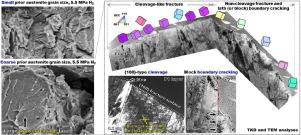Acta Materialia ( IF 9.4 ) Pub Date : 2021-01-10 , DOI: 10.1016/j.actamat.2021.116635 L. Cho , P.E. Bradley , D.S. Lauria , M.L. Martin , M.J. Connolly , J.T. Benzing , E.J. Seo , K.O. Findley , J.G. Speer , A.J. Slifka

|
This study presents an in-depth characterization of the microstructures, crystallographic orientations, and dislocation characteristics beneath hydrogen-induced quasi-cleavage fracture features of an as-quenched, lath martensitic (α') 22MnB5 steel. The fracture surfaces of gaseous hydrogen-embrittled martensitic specimens were analyzed by a combination of multiple analytical tools: scanning electron microscopy (SEM), electron backscatter diffraction (EBSD), transmission electron microscopy (TEM), and transmission Kikuchi diffraction (TKD). The dominant fracture mode in the hydrogen-affected zones was quasi-cleavage fracture, which involved significant plasticity, evidenced by plastic zones near tear ridges and a high density of dislocations beneath the quasi-cleavage facets. The martensite constituent sizes, variant orientations, and boundaries influenced the quasi-cleavage surface morphologies. Fractography revealed the occurrence of {100}α'-type cleavage across martensitic laths, developing relatively “flat” quasi-cleavage surfaces, in addition to {110}α'-type cracking likely along lath and block boundaries, and fracture along non-cleavage planes. The likelihood of the formation of the relatively “flat” quasi-cleavage surfaces increased with increasing martensitic constituent sizes. Substantial dislocation bands formed on intersecting {112}α' slip planes within a martensite block below the hydrogen-induced cleavage fractures on {100}α' planes. River markings on the quasi-cleavage surfaces were found to originate from the complex, hierarchical lath martensitic microstructure. Steps and ridges on the quasi-cleavage facets generally linked with the various martensitic boundaries, suggesting that they were produced as a result of crack deviations at those boundaries. The fracture paths and martensite quasi-cleavage mechanisms are discussed in the context of the role of hydrogen and Cottrell cleavage model.
中文翻译:

板条马氏体钢的氢致准裂解断裂特征及机理
这项研究对淬火后的板条马氏体(α')22MnB5钢的氢诱导的准解理断裂特征下的微观结构,晶体学取向和位错特征进行了深入的表征。气态氢化马氏体标本的断裂表面通过多种分析工具进行了分析:扫描电子显微镜(SEM),电子背散射衍射(EBSD),透射电子显微镜(TEM)和透射菊池衍射(TKD)。氢影响区的主要断裂模式为准劈裂断裂,其具有显着的可塑性,其表现为撕裂脊附近的塑性区和准劈裂面下方位错的高密度。马氏体成分的大小,方向的变化,和边界影响准劈裂的表面形态。断口扫描显示{100}的发生除沿板条和块体边界的{110} α'型开裂以及沿非开裂面的断裂外,整个马氏体板条上的α'型开裂,发展出相对“平坦”的准裂解面。随着马氏体成分尺寸的增加,形成相对“平坦”的准劈裂面的可能性增加。在{100} α'上的氢致劈裂裂缝下方的马氏体块内,在相交的{112} α'滑移面上形成大量位错带。飞机。发现准解理面上的河流痕迹源自复杂的,分层的板条马氏体微观结构。准解理面上的台阶和脊通常与各种马氏体边界相关联,表明它们是由于这些边界处的裂纹偏差而产生的。在氢和科特雷尔裂解模型的作用下,讨论了断裂路径和马氏体准裂解机理。



























 京公网安备 11010802027423号
京公网安备 11010802027423号